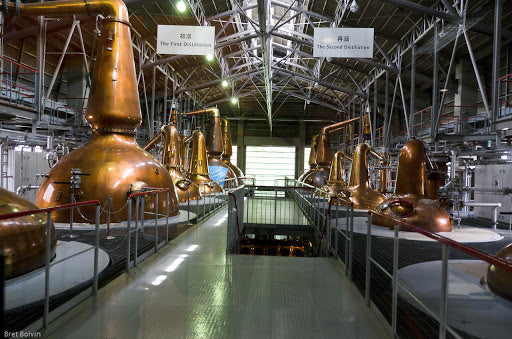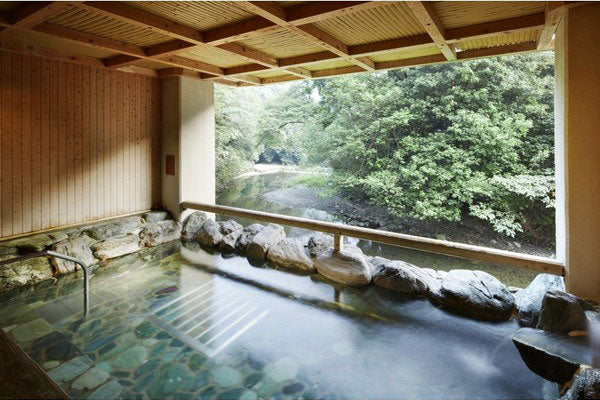The Distillery Hidden In A Forest: The Most Scenic Distillery You'll Ever Find
Distillery Spotlight: Hakushu Distillery
Region: Hokuto, Yamanashi Prefecture, Japan
Note: Our Distillery Spotlight articles discuss how each distillery's unique process results in the distinctive flavour profiles of their whisky. To find out more about each step of the whisky-making process, check out our Basics Series article on how to distil the elixir of life.

(Image Source: Suntory)
Half a century after the Yamazaki distillery was first established, the Hakushu distillery was completed in 1973, when Suntory had decided to expand their stable of distilleries to further catch the momentum of a growing whisky market in Japan. They had sought to create a new whisky that was distinctively different from both Yamazaki and Scotch whisky. This was to further differentiate Japanese whisky as a category separate of Scotch and build an identity of its own, especially after initial efforts by Suntory to imitate Scotch whisky had flopped in Japan.
Hakushu distillery finds itself amidst lush forestry that is wildly scenic, surrounded by mountain ranges, and also happens to be the highest elevated distillery, at an altitude of more than 2,000 feet above sea level. It is for this reason that Hakushu is also known as the “Mountain Forest Distillery”. As we’ll uncover, much of this was a deliberate effort by Suntory to channel Hakushu’s natural climate into a unique whisky of its own.
Fun Fact: Hakushu believes in co-existing with its surroundings and has set aside more than 820,000 square metres of forested land and has even established a wild bird sanctuary.


(Image Source: Suntory)
The Origins of Hakushu – It’s The Location, Location, Location (Again)
As we saw in Yamazaki’s origins, Suntory has always believed in the importance of the water source for its whiskies (a belief shared by Japanese tea and sake makers). This set them on a quest to search for high quality water for mashing (the process by which starch from the barley malt is turned into fermentable sugars by enzymes), and had found themselves in the town of Hakushu, in the Yamanashi Prefecture, sandwiched between Tokyo and Nagano.

(Image Source: Suntory)
Hakushu finds itself at the base of the Southern Alps of Mount Kai Komagatake, where water from its snowcaps melts and makes its journey down the mountain range where it is drawn from the Ojira River. It is surrounded by heavy and lush forestry at a high elevation which offers cool and clear air while maintaining a humid climate.
This makes Hakushu highly unique in being the only distillery in the world to occupy a heavily forested, high-elevation location. And what makes for a unique location certainly makes for a unique whisky.

(Image Source: Suntory)
The Source of It All – Hakushu’s Unique Soft Waters
Hakushu is famous for having one of the highest-quality water sources in Japan, so much so that it received official designation from Japan’s Ministry of Environment. In fact, Suntory even bottles its own mineral water under the Tennensui brand in Hakushu, which happens to be a highly popular brand in Japan.
As mentioned, Hakushu draws its water from the Ojira River, a river that comes together with another nearby river, the Jingu River, to form a white sand bar in the shape of a fan at the foot of the mountain. It is for this reason that the town was named Hakushu, which means “white sandbar”.

(Image Source: Suntory)
In every bottle of Hakushu, you will find water from Mount Kai Komagatake’s snowcaps that have melted and flowed through a series of natural springs. This fresh snow water is purified by having passed through the many natural granite filters found underground and as such also has a lower mineral content than the water used in other distilleries, making it much softer, yet sharp in taste. This allows whisky mashed using these waters to have a pleasant and gentle flavor, distinct from the deeper, stronger taste found in Yamazaki.
The Higher The Better – Altitude to Attitude
A higher altitude with lower atmospheric pressure allows distilleries to reduce the number of distillations required to remove impurities in the whisky. As distillation not only removes impurities but also phenyls and esters that give a whisky its complex flavor profile, fewer distillations also means a whisky is able to retain more phenyls and esters making for a more robust whisky.

(Image Source: Bret Boivin)
Given that Hakushu finds itself at a uniquely high elevation, this means less distillation is required, and the whisky is able to keep more of its flavors, thereby better expressing the gorgeous natural climate that it is surrounded by. This is further amplified by the use of softer waters that allows its profile to go on full orchestra mode.
The cool, clear air and humidity that comes with being in the middle of a forest and at such altitudes, further affects the final whisky when it is matured in casks stored in on-site aging warehouses. In humid climates such as Hakushu, alcohol evaporates faster than the water inside the cask, leaving more water than alcohol in the cask and lowering the ABV of the whisky. Hence according to Japanese whisky expert Nomunication, Hakushu keeps smaller sized casks to be matured onsite, to reduce the angel’s share (evaporation of alcohol in the cask), which is observed to be 3% in Hakushu annually, higher than the average of 2% elsewhere.

(Image Source: Suntory)
To put the pieces together, Hakushu faces higher rates of alcohol evaporation due to the humidity of its natural climate, and as such tries to lessen this through the use of smaller casks with less surface area for evaporation. Humidity certainly plays a big role here as the coolness would otherwise actually reduce the evaporation.
Interestingly this makes the effect of Hakushu’s climate on the whisky’s maturation slower and more gentle, closer to that of Scotland’s. It is for this reason that Hakushu the location was chosen, to demonstrate the effect of Japanese whisky-making combined with an otherwise Scottish climate. As such, many whisky drinkers have found Hakushu to spot a much more Scotch-like character than Yamazaki.

(Image Source: All About Japan)
The Hakushu Whisky Making Process
As Suntory places a high emphasis on blending, Hakushu, like Yamazaki, boasts a large distillation facility with multiple stills that allows for a wide variety of Hakushu expressions to be produced and subsequently blended.
However, where Hakushu does differ is in its sole use of wooden washbacks versus Yamazaki’s combination of wooden and stainless steel washbacks or other Japanese distillery’s use of Mizunara washbacks (such as Chichibu). This allows the lactobacillus (which is what makes yoghurt and cheese from milk) that is found naturally amidst Hakushu’s forested surroundings to contribute to the fermentation of the malt.

(Image Source: BrewOf)
Another aspect that stands out is that Hakushu is the only distillery in Suntory’s stable to use peated malt (which it imports from Scotland). As the water used in Hakushu is soft and contains much less mineral content than usual, the lightly peated malt is able to offer a smokier profile without it becoming a peat bomb that is more common across Scotch whiskies.
 (Image Source: Gear Patrol)
(Image Source: Gear Patrol)
This is Hakushu
As we now know, what makes Hakushu distinctive is its unique location, which is both cool yet humid amidst the Southern Alps at an atypically high elevation, the water used, which is softer and less mineral rich, and the peated malt used, which gives it a smoky profile. Certainly being nestled in the forest has an impact on Hakushu’s distillate as well. To crystallise Hakushu’s character, we tend to see it spot the following profile:
Color:
- Light Gold, Champagne, Pokka Green Tea
Nose:
- Smoky, Fresh Toast (Young Hakushu)
- Deep Smoke, Whole Grain Loaf, Country Loaf (Older Hakushu)
- Herbaceous, Peppermint, Fresh Pine, Light Grassy-ness
- Freshly Cut Crisp Cucumber Slices, Watermelon, Tomatoes
Palate:
- Light Smokey-ness (Young Hakushu)
- Rich Thick Smokey-ness (Older Hakushu)
- Citrus Zest, Fresh Cucumber and Watermelons, Grassy, Rosemary
- Slight Bitter Herbaceous Tang
- Nutty, Almonds and Walnuts
- Refreshing Sweetness, Cinnamon Buns, Stewed Raspberries
Finish:
- Short, Refreshing and Punchy, Citrus Peels (Young Hakushu)
- Longer, Dried Raisin, Manuka Honey, Herbal, Bittersweet Oak-iness (Older Hakushu)

(Image Source: Suntory)
Our Take
Hakushu finds itself somewhere between Yamazaki and your typical Scotch. While it is smokier than most Japanese whiskies, it is also much lighter, smoother and tame, much like a gentle tinder. It embodies much of the climate with which it was distilled in, almost like spring captured in a time-capsule that is a whisky bottle. It is clean, crisp, refreshing, much like a cool evergreen breeze through a Fir or Pinecone forest or a jug of water you find in brunch cafes, infused with citrus fruits, tart cucumber slices, rosemary and charcoal bits.

(Image Source: Suntory)
As it ages, much like the seasons, its flavor transitions from spring to autumn, taking on richer, sweeter, more herbal notes, of dried fruits and Manuka honey.

(Image Source: Osaka Ryokan)
It is for this gorgeous spectrum that mirrors the seasons, Hakushu goes superbly well as a Highball Cocktail, which is our preferred way to enjoy Hakushu. In fact, Hakushu goes so well with Highballs that a special Highball, named Morikaoru or “Forest Aroma”, was created to pair with Hakushu. If you get the chance, have yourself a flight of Hakushu Highballs from the 12 Year all the way up to the 18 Year and we promise you, it’ll almost feel like you travelled through the seasons. So close your eyes and imagine yourself seated in a traditional Japanese Ryokan on a tatami mat enjoying the cool spritely spring breeze all the way to the deep mellow autumn falls. That’s Hakushu for you.

(Image Source: Suntory)
Our favorites are:
Entry Level: Hakushu Distiller’s Reserve; Hakushu 12 Year
Moderate: Hakushu 18 Year; Hakushu Bourbon Barrel
Top Shelf: Hakushu 25 Year

@111hotpot






